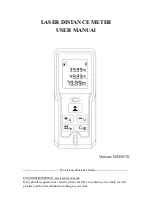
Volume VII–System Description
OMEGA EP Operations Manual
Page 6 of 35
1.1.3.2 OMEGA EP Fast-Ignition Program
The key experiments needed to demonstrate the fast-ignition concept and determine the optimum
parameters for the NIF will be carried out on OMEGA and OMEGA EP. The fundamental goal is to
determine the coupling of the HEPW beam energy to the compressed core of a cryogenic implosion.
Experiments will include the propagation of the high-intensity laser beam in the target, the conversion
efficiency of the laser light to hot electrons (or ions), the intensity scaling of the hot-particle energy, the
transport of these particles, and the heating of the compressed core.
1.1.3.2.1 Intensity Scaling of Hot-Electron Energy
The coupling efficiency to DT or plastic targets may be different than for high-
Z
targets and is
a major uncertainty in the fast-ignition scheme. In addition, the relationship between the hot-electron
temperature
T
hot
and the ponderomotive potential
U
pond
of the high-intensity beam appears to be a
function of target
Z
. This will be determined experimentally in planar cryogenic target experiments in
the OMEGA EP target chamber. The beam intensity will be varied by changing the compressed pulse
duration in the 1- to 10-ps range.
1.1.3.2.2 Electron-Beam Transport
HEPW-generated electron-beam propagation without excessive divergence is important for
fast ignition. For example, the compressed core on OMEGA is only ~80
n
m in diameter and remains
assembled for less than ~100 ps, dictating a tight specification on the pointing accuracy of the channeling
and ignitor beams. At the same time, the critical-electron-density (
n
c
) contour for 1-
n
m light has a
430-
n
m radius while the 10
n
c
contour has a 150-
n
m radius. From this approximate characterization of
the radial density profile, it is clear that the propagation of the high-intensity beams through the overdense
plasma region requires good collimation and directionality of the electron beam that is generated at the
end of the laser propagation. Studies of these processes will be carried out in the OMEGA EP chamber
followed by full-scale, integrated implosion experiments in the OMEGA chamber with the compressed
OMEGA EP beams used as the channeling and ignitor beams. The cone-in-shell fast-ignitor concept
will also be validated.
1.1. SSP-Related High-Energy-Density Physics
Areas of high-energy-density physics of interest to NNSA’s Stockpile Stewardship Program (SSP)
include (1) dynamic materials studies, including high-pressure equation-of-state (EOS) experiments of
materials at high energy density, and (2) compressible hydrodynamics and radiative hydrodynamics
experiments. The OMEGA EP target chamber design is optimal for both classes of experiments because
all the laser energy is incident from one direction. The ability to heat compressed materials with high-
intensity beams and the advanced radiographic capabilities are equally valuable.
A related area is the study of matter near and above solid density at temperatures that can vary
from a few electron volts to several hundred electron volts. There are applications in planetary and
earth sciences, in addition to ICF and HED physics, including studies of the EOS and other materials
properties relevant to high-pressure planetary interiors. Challenges presented by this field include
producing controlled conditions and their diagnosis. A number of complementary techniques can be
used on OMEGA EP to access these conditions.
Summary of Contents for Volume VII-System Description
Page 38: ......









































